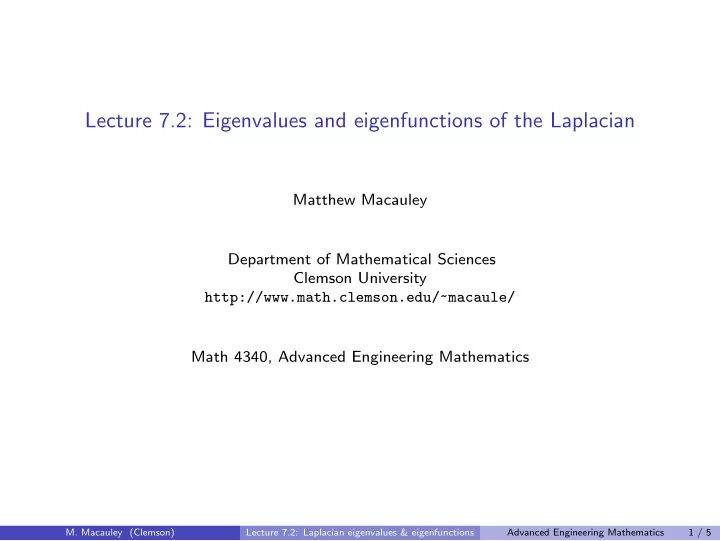

Lecture 7.2: Eigenvalues and eigenfunctions of the Laplacian Matthew Macauley Department of Mathematical Sciences Clemson University http://www.math.clemson.edu/~macaule/ Math 4340, Advanced Engineering Mathematics M. Macauley (Clemson) Lecture 7.2: Laplacian eigenvalues & eigenfunctions Advanced Engineering Mathematics 1 / 5
Overview The Laplacian is the differenital operator n ∂ 2 ∆ = ∇ 2 := � . ∂ x 2 i i =1 In the previous lecture, we found the kernel of this operator (for n = 2) under various boundary conditions. This amounted to solving a PDE called Laplace’s equation: ∆ u = 0 . In this lecture, we will find the eigenvalues and eigenfunctions of ∆. This amounts to solving a PDE called the Helmholtz equation: ∆ u = − λ u . This equation arises when solving the heat and wave equations in two dimensions. M. Macauley (Clemson) Lecture 7.2: Laplacian eigenvalues & eigenfunctions Advanced Engineering Mathematics 2 / 5
Dirichlet boundary conditions Example 1 Find the general solution to the following BVP for the Helmholtz equation u xx + u yy = − λ u , u (0 , y ) = u ( π, y ) = u ( x , 0) = u ( x , π ) = 0 . M. Macauley (Clemson) Lecture 7.2: Laplacian eigenvalues & eigenfunctions Advanced Engineering Mathematics 3 / 5
Neumann boundary conditions Example 2 Find the general solution to the following BVP for the Helmholtz equation u xx + u yy = − λ u , u x (0 , y ) = u x ( π, y ) = u y ( x , 0) = u y ( x , π ) = 0 . M. Macauley (Clemson) Lecture 7.2: Laplacian eigenvalues & eigenfunctions Advanced Engineering Mathematics 4 / 5
Mixed boundary conditions Example 3 Find the general solution to the following BVP for the Helmholtz equation u xx + u yy = − λ u , u (0 , y ) = u x ( π, y ) = u y ( x , 0) = u y ( x , π ) = 0 . M. Macauley (Clemson) Lecture 7.2: Laplacian eigenvalues & eigenfunctions Advanced Engineering Mathematics 5 / 5
Recommend
More recommend